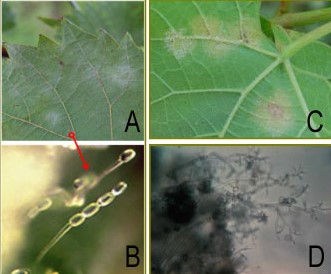Vinews
No. 14 — Sept. 7, 2020
Contents:
- Time To Think About The 2021 Grape Growing Season
- Know the Difference Between Potassium Bicarbonate and Phosphorous Acid Fungicides
Time To Think About The 2021 Grape Growing Season
Though grape harvest season is at full throttle, remember that 2021 is just around the corner. This week is a gentle reminder that disease pressure will likely increase as the 2020 growing season comes to an end. As a walked through vineyards this week, I noticed downy mildew starting to take hold even after some growers had applied two applications of phosphorous acid fungicide. Maintaining the health of the leaves of the canopy after harvest will pay dividends in 2021.
Maintaining the canopy after harvest is important for 2021 crop. Prior to removal of the crop from the vine at harvest, the clusters are the main storage sink for soluble sugars. Once the crop is removed from the vine, the roots, trunk, cordons, and spurs become the main sink for the soluble sugars produced by the leaves. These soluble sugars are converted to starch and stored mainly in the xylem and phloem ray cells. When vine growth resumes in the spring, the starches are converted soluble sugars and used by the grapevine for both shoot and root growth. Adequate amounts of stored soluble sugars are also important for regulating cold hardiness in the grapevine. The hydrolysis of stored starch leads to an accumulation of soluble sugars resulting in cold hardiness.
The main fungal diseases that can impair photosynthesis after grape harvest are downy mildew and powdery mildew. Harvested grapevines can be protected from downy mildew with an application of fungicide containing the active ingredient mancozeb. An outbreak of downy mildew can be cleaned up with a phosphorous acid fungicide. Grapevines that are not sulfur sensitive can be protected from powdery mildew by applying sulfur. To protect sulfur sensitive grapevines from powdery mildew select a fungicide that has reduced risk for selecting for powdery mildew resistance. Most of the fungicides or fungicide combinations that control powdery mildew are considered medium to high risk for selecting for resistance development. Consider instead using Fracture (FRAC M), Quintec (FRAC 13), Torrino (FRAC U6) or Vivando (FRAC U8). An outbreak of powdery mildew can be cleaned up with a potassium bicarbonate fungicide.
Maintain the grape canopy for a minimum of four weeks after harvest. Take the time to scout the harvested vineyard to determine what fungal pests are present. Determine which grape cultivars are most susceptible to either downy mildew, powdery mildew, or potentially both. Try to limit your fungicide inputs by scouting. If no fungal pressure is present then delay your spray program. Pay attention to the weather forecasts to determine if an extended wetting period may be in the immediate future. For late harvested cultivars, it is important to be aware of a potential of a killing frost. Do not apply a fungicide to vineyard that will experience a killing frost in a short period of time-save your time and money.
Maintaining the grape leaf canopy after harvest is what will drive your 2021 growing season. A fully functional leaf canopy after harvest results in the vines taking up a burst of nitrogen from the soil. Approximately 30% of a grapevines nitrogen needs for the next growing season is taken up after grape harvest. The nitrogen is stored in the root cells. Some of the nitrogen will be carried up the grapevine in the transpiration stream to the leaves and shoots. However, the majority of the nitrogen after harvest is stored within the grape roots. This stored nitrogen in the roots and the stored starch are the keys to starting a successful 2021 growing season.
In summary, keep the leaf canopy functioning after harvest. Also, the larger the crop load (more than 8 tons/acre) the more time the grapevines need to recover after harvest.
Know the Difference Between Potassium Bicarbonate and Phosphorous Acid Fungicides

- Potassium bicarbonate fungicides (examples include Kaligreen and Milstop) have activity only on powdery mildew and are often applied when sporulating colonies are found, but potassium bicarbonate fungicides do not protect the tissue from new infections of powdery mildew.
- Phosphorous acid fungicides (Examples include Phostrol, Prophyt, and Reliant) have activity on downy mildew. Often Phosphorous acid fungicides are used after an infection period occurred or when active infections of downy mildew are found. If applied as a curative use the higher labeled rate.
Which means identifying the target pest:
- If symptomology alone does not help you identify if the problem is downy or powdery mildew then look at the sporulating structure using a 20X hand lens.
- Powdery mildew appear as small little barrels all stacked on top of each other. Scientifically the barrels are conidia and the structure the conidia are attached to is a conidiophore.
- Downy mildew appear as branched trees with round globes attached to the branches. Scientifically the globes are sporangia and the branched tree structure is a sporangiophore.